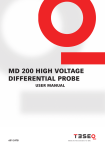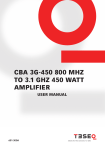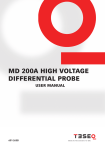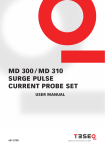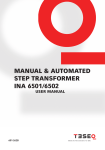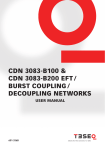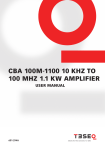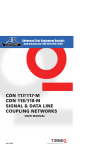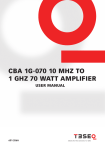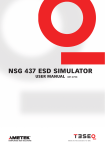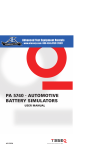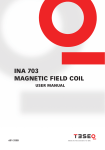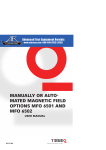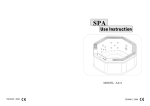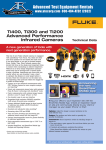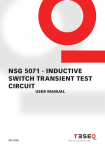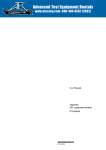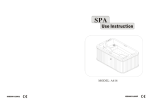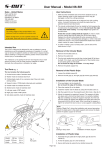Download 601-266B - MD 103 User Manual english.indd
Transcript
® E stablished 1981 Advanced Test Equipment Rentals www.atecorp.com 800-404-ATEC (2832) 1 MD 103 ESD Target Set User Manual 601-266B MD 103 ESD Target Set User Manual MD 103 ESD target set contentS 1 Safety terms and symbols 2 The ESD target set 3 Handling of the target set 4 Requirements by a new draft standard 5 Using the target 6 Relation between voltage and real current flowing 7 Preparing the target for calibration with INA 103 adapter 8 Calibrating the target using INA 103 option 9 Determining the low frequency transfer impedance 10 Technical specifications MD 103 11 Ordering information 12Addresses 5 6 7 9 10 12 13 16 19 20 21 22 1 Safety terms and symbols Please take note of the following explanations of the symbols used in order to achieve the optimum benefit from this manual and to ensure safety during operation of the equipment. The following symbol draws your attention to a circumstance where nonobservation of the warning could lead to inconvenience or impairment in the performance. Example: Caution statements identify conditions or practices that could result in damage to this product or other property. 5 6 2 The ESD target set An ESD target is a shunt for measuring the ESD discharge current flowing in a measurement circuit. The target is intended to emulate a discharge into a perfect ground plane. To minimize the error caused by any difference between a perfect conducting plane and the input impedance of the target, a 2.1 Ω limit has been set for the input impedance. The impedance of the MD 103 target is 1.03 Ω. An even smaller impedance value would generate a very small output signal which would be subject to errors due to coupling into cables and oscilloscope. A very important parameter of the target is the DC transfer impedance Z SYS, this is the ratio between the voltage measured on the scope and the real current flowing through the target. For the exact value, please refer to the calibration certificate. MD 103 ESD target set 3Handling of the target set The target consists of the complete set with cable, attenuator and discharge part (target) like the pictures below. The MD 103 is a high precision device, please handle with care. Leave the ESD target with the attenuator and the cable together and do not disassemble the set in parts, since the whole coupling path has been calibrated in one piece. 7 8 MD 103 parts identification: Carry case User manual Calibration certificate ESD target Attenuator 20 dB Coax cable Sucoflex The carry case has extra space for the calibration adapter INA 103, the special screw tool and an adapter to connect to an analyzer or to a scope. MD 103 ESD target set 4Requirements by a new draft standard In order to improve the reproducibility between calibration laboratories, the frequency characteristic of the target has now been defined in a new draft standard submitted by ANSI and IEC. The new draft of the standard sets limits for the insertion loss of the whole measurement chain including the target itself, cables and any attenuator present. The variation in the insertion loss of the chain may not exceed: +/- 0.3 dB up to 1 GHz +/- 1 dB between 1 GHz and 4 GHz The MD 103 shows an almost flat frequency response up to 4 GHz. The next figure shows the insertion loss of the MD 103 (solid line) and the permitted tolerances (dotted lines). Reflection coefficent [dB] –47 –48 –49 –50 0 1·109 Frequenzy [Hz] 2·109 3·109 4·109 4 GHz 9 5 Using the target The MD 103 target comes fully assembled ready to be screwed into the reference plane. The plane should be at least 1.2 x 1.2 m in size and forms part of a HF-tight enclosure for cables, attenuators and the oscilloscope. Shielded enclosure for the oscilloscope and connecting cables 1.2 m Ground plane ESD simulator Current target 1.2 m 10 Ground strap (pulled away at its midpoint) Ground strap connection point Power cord RF filter for AC power Typical arrangement for calibration of ESD simulator performance. MD 103 ESD target set This is the drilling template for the reference plane. 11 45° Canter hole 51 + 0.5 mm Thread M3 60 mm Schematically, the measurement chain looks as follows. Frequency response of cables, attenuator and connectors >>2 GHz Oscilloscope min. 2 GHz analogue bandwidth 12 6Relation between voltage and real current flowing To get the peak current, a suitable scope will be needed as well as the exact transfer impedance ratio value Z SYS, which is found in the calibration certificate. If the target is mounted, and the measuring setup conforms to the standard recommendations, then following calculation has to be made to get the current. Measured peak voltage [V] Low frequency transfer impedance ratio [Ω] = Pulse peak current [A] Numeric example: Set the ESD simulator to 8 kV and discharge directly to the target so the peak voltage on the scope in the 50 Ω system is 2.89 V. The transfer impedance for 1 the MD 103 is Z SYS = 0.098 Ω or 10.3 Ω [Siemens]. 2.89 V 0.098 = 29.49 A So the calculated peak current flow is 29.49 A by 8 kV ESD voltage. To fulfill the IEC/EN 61000-4-2 recommendation the 30 ns and the 60 ns point needs to be measured and calculated, too. MD 103 ESD target set 7 Preparing the target for calibration with INA 103 adapter The optional INA 103 is needed if the target has to be calibrated. The INA 103 calibration adapter can be placed in the MD 103 carry case. For calibration, unscrew the center contact bolt with the special screw tool and remove it carefully. 13 14 Unscrew the INA 103 connector socket from the calibration ring. Disassemble the INA 103 adapter to the following parts. Connector socket Calibration ring The center pin of the connector socket can be disassembled to into connector pin, isolator and screw bolt. Connector pin Isolator Screw bolt Screw now the calibration ring onto the target. MD 103 ESD target set Screw from the center pin the screw bolt into the target, add the isolator and screw the connector pin into the screw bolt. Screw the connector socket onto the calibration ring. The assembled target with the calibration adapter is now ready to be used for calibration. 15 16 8Calibrating the target using INA 103 option According to the new draft standard, the insertion loss of the target should be measured with a network analyzer. The network analyzer has two coaxial connection ports. For insertion loss measurements on the target an adapter is necessary, which provides a matched low reflection from the front side of the target to the coaxial connector of the network analyzer. Network analyzer Signal OUT Attenuator B Calibration adaper INA 103 Signal IN MD 103 ESD target Attenuator C Cable A Attenuator A Calibrate the network analyzer at this point The ESD current target, attenuator A and cable A are the target-attenuatorcable chain which is calibrated using this setup. Attenuator B and C may not be needed. For a proper connection to an analyzer or scope an adaptor may be needed and can be placed into the spare place of the MD 103 carry case. MD 103 ESD target set In order to minimize the influence of the adapter on the measurements, frequency parameters of the adapter are specified in the draft. These parameters are verified for two adapters connected face to face. They must be as follows: Reflection coefficient: < -30 dB up to 1 GHz < -20 dB between 1 GHz and 4 GHz –15 –20 Reflection coefficent [dB] –25 –30 –35 –40 –45 –50 –55 –60 0 1·109 2·109 3·109 4·109 4 GHz Frequenzy [Hz] Reflection coefficient of two adapters for the MD 103 placed face to face (solid line) and the permitted tolerance (dotted line). 17 Insertion loss must be better than -0.3 dB up to 4 GHz. 0 Reflection coefficent [dB] 18 -0.2 0.4 0 1·109 2·109 3·109 4·109 Frequenzy [Hz] Insertion loss of two adapters for the MD 103 placed face to face (solid line) and the permitted tolerance (dotted line). Moreover the characteristic impedance of the adapter must be within the limit of 50 Ω +/- 2% (i.e. it must be between 49 and 51 Ω). The adapter is an assembly of coaxial cylinders with a diameter for the outer cylinder D = 16 mm +/- 0.02 mm and a diameter of the inner cylinder d = 7 mm +/- 0.02 mm. The formula for calculating the characteristic impedance is as follows: D Zw = 60 ∙ ln d The calculated characteristic impedance of the adapter is therefore 49.6 Ω. Taking into account the tolerances, this impedance is no greater than 49.35 Ω and no less than 49.84 Ω. Another significant element of the adapter is the professional connector type N-7/16 (Huber Suhner). The producer of the connector guarantees 50 Ω +/-2% characteristic impedance up to 7.5 GHz. The requirement concerning the characteristic impedance of the adapter for the MD 103 is hence fulfilled. MD 103 ESD target set 9 Determining the low frequency transfer impedance The low frequency transfer impedance of a target-attenuator-cable chain is defined as the ratio between the current injected at the front face of the target and the voltage across a precision 50 Ω load at the output end of the cable. The circuit diagram for measuring the low frequency transfer impedance looks as follows: TargetAttenuatorCable 50 Ω A R SYS The low frequency transfer impedance can be determined by: Injecting a DC or LF current ISYS of approx. 1 A into the front face of the target. Measuring the voltage V 50 across the precision 50 Ω. Calculating the transfer impedance as follows: D50 Zw = ISYS V V50 19 20 10Technical specifications MD 103 Insertion loss (S21 parameter): Average low frequency transfer impedance: Inner target diameter: Impedance: Calibration ESD pulse amplitude: Max. ESD pulse amplitude: Calibration adapter reflection coefficient: Target parts: Cable connectors: MD 103 ESD target set < -48.3 dB DC to 4 GHz ZSYS = 0.098 Ω 7 mm 1.03 Ω (SMD design) 1/2/4/8/15 kV 30 kV < -40 dB up to 1 GHz < -25 dB between 1 GHz and 4 GHz Gold plated Type N 11Ordering information MD 103 ESD calibration target set Including: Carry case User manual Calibration certificate ESD target Attenuator 20 dB Coax cable Sucoflex Options: INA 103 Calibration adaptor with special screw tool 21 Headquarters Teseq AG 4542 Luterbach, Switzerland T + 41 32 681 40 40 F + 41 32 681 40 48 sales @ teseq.com www.teseq.com Manufacturer Teseq AG 4542 Luterbach, Switzerland T + 41 32 681 40 40 F + 41 32 681 40 48 sales @ teseq.com China Teseq Company Limited T + 86 10 8460 8080 F + 86 10 8460 8078 chinasales @ teseq.com France Teseq Sarl T + 33 1 39 47 42 21 F + 33 1 39 47 40 92 francesales @ teseq.com Germany Teseq GmbH T + 49 30 5659 8835 F + 49 30 5659 8834 desales @ teseq.com Japan Teseq K.K. T + 81 3 5725 9460 F + 81 3 5725 9461 japansales @t eseq.com Singapore Teseq Pte Ltd. T + 65 6846 2488 F + 65 6841 4282 singaporesales @ teseq.com Switzerland Teseq AG T + 41 32 681 40 50 F + 41 32 681 40 48 sales @ teseq.com Taiwan Teseq Ltd. T + 886 2 2917 8080 F + 886 2 2917 2626 taiwansales @ teseq.com UK Teseq Ltd. T + 44 845 074 0660 F + 44 845 074 0656 uksales @ teseq.com USA Teseq Inc. T + 1 732 417 0501 F + 1 732 417 0511 Toll free +1 888 417 0501 usasales @ teseq.com © December 2010 Teseq® Specifications subject to change without notice. Teseq® is an ISOregistered company. Its products are designed and manufactured under the strict quality and environmental requirements of the ISO 9001. This To find your local partner within document has been carefully checked. Teseq®’s global network, please go to However, Teseq® does not assume www.teseq.com any liability for errors or inaccuracies.






















